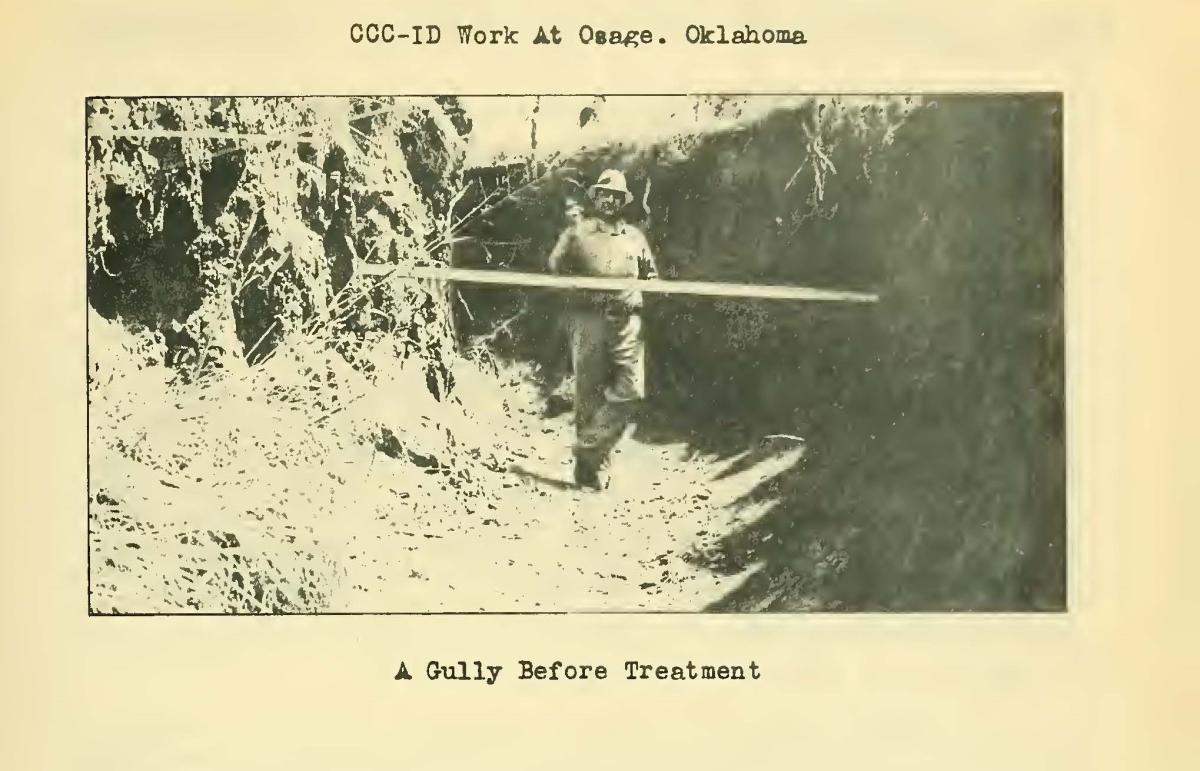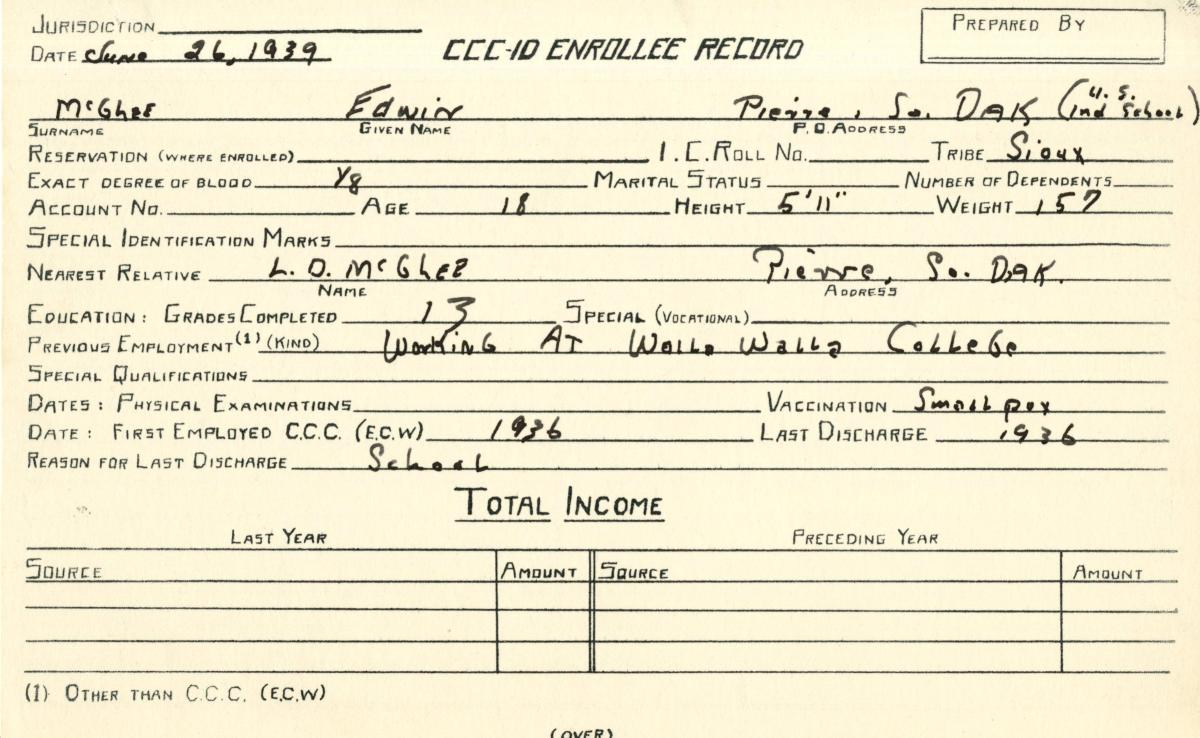
Records of the Civilian Conservation Corps–Indian Division
The Civilian Conservation Corps–Indian Division (CCC-ID) was established in the 1930s to help American Indians impacted by the Great Depression.
The National Archives has multiple series of records relating to the CCC–ID, including correspondence, reports, employment applications, and photographs.
Historical Overview
Congress established the Emergency Conservation Work (ECW) program on March 31, 1933 (48 Stat. 22). Over $5,000,000 was initially allocated to the Bureau of Indian Affairs (BIA) to coordinate emergency conservation work on federally recognized American Indian reservations.1 The BIA’s Forestry Division initially oversaw this work, but on May 22, 1933, a separate Indian Emergency Conservation Work Division (IECW) was established with its own director and multiple field districts. When the ECW became the Civilian Conservation Corps (CCC) on July 1, 1937, the name of the IECW was likewise changed to the Civilian Conservation Corps Indian Division (CCC-ID). Daniel E. Murphy was the director of both the IECW and the CCC-ID throughout most of their existence, although the director of the CCC approved the program’s funding.2
The dual objectives of the CCC-ID program were to provide employment for American Indians and to accomplish useful conservation work. The BIA, in consultation with tribal authorities, selected and trained CCC-ID enrollees. Enrollment was open to American Indians over age 18 who were physically fit. Most enrollees worked close to home on their own reservations. CCC-ID enrollees were paid the same as their white counterparts (i.e., $30 per month plus room and board) if they lived in CCC camps. They could also choose to live at home, in which case they earned a smaller stipend (e.g., $15 per month in 1936). In the first three years of the program (July 1933–June 30, 1936), the BIA estimated that over 30,000 American Indians had been employed in emergency conservation work.3
The BIA was also responsible for managing and operating CCC-ID projects in consultation with tribal authorities. Projects included fire prevention work, road and trail construction, weed and pest control, construction of telephone lines, fence construction, erosion and flood control work, water supply projects, planting of trees and forest improvement work, and other activities.4
The CCC-ID field work was terminated on July 10, 1942, although the Washington office staff continued to operate for some time to complete its affairs.5
BIA Headquarters Records
The National Archives in Washington, DC (Archives 1), has headquarters-level records of the BIA in Record Group 75. These records include administrative correspondence and reports related to the CCC-ID’s operations nationwide; select series are listed below.
For the full archival records descriptions in the National Archives Catalog, please select the National Archives Identifiers provided. For questions related to these series, please email the Archives 1 Reference Branch at archives1reference@nara.gov.
- “General Records, 1933–1944” (National Archives Identifier 2103102)
- A box list is available in the National Archives Catalog.
- “Records Concerning the Enrollees Program, 1937–1942” (National Archives Identifier 2103170)
- A folder list is available in the National Archives Catalog.
-
“Narrative and Pictorial Reports, 1937–1942” (National Archives Identifier 2103200)
- “Records Relating to the Magazine Indians at Work, 1936–1942” (National Archives Identifier 2103207)
BIA Field Office Records
BIA field office records can include correspondence, reports, work plans, pay and appropriation ledgers, personnel files, and other records related to CCC-ID enrollees and projects on individual American Indian reservations. These records are housed at National Archives research facilities based on the state in which the field office was located.
Examples are listed below. Select the National Archives Identifiers for the full archival records descriptions in the National Archives Catalog. For questions related to the records, please contact the National Archives research facility indicated.
- Cherokee Indian Agency: “Records Relating to Activities of the Civilian Conservation Corps (Indian Division), 1936–1943” (National Archives Identifier 279381)
- Contact the National Archives at Atlanta for more information.
- Fort Belknap Agency: “Civilian Conservation Corps Enrollee Records, 1938–1942” (National Archives Identifier 2579577)
- Contact the National Archives at Denver for more information.
- Hoopa Valley Agency: “Administrative Files Relating to the Civilian Conservation Corps Indian Division Activities, 1933–1943” (National Archives Identifier 55318359)
- Contact the National Archives at San Francisco for more information.
- Mission Agency: “Employment Applications for Civilian Conservation Corps–Indian Division (CCC-ID) Enrollees, 1937–1939” (National Archives Identifier 16972792)
- Contact the National Archives at Riverside for more information.
- Pierre Indian School: “Enrollee Identification Cards, 10/19/1937–8/29/1938” (National Archives Identifier 6016162)
- This series is partially digitized in the National Archives Catalog.
- Contact the National Archives at Kansas City for more information.
- Ponca Subagency: “Central Classified Files Relating to the Civilian Conservation Corps–Indian Division (CCC-ID), 1935–1943” (National Archives Identifier 2573120)
- Contact the National Archives at Fort Worth for more information.
- Sac and Fox Agency and Sanitorium: “Civilian Conservation Corps Indian Division Employee Records, 1933–1942” (National Archives Identifier 4730924)
- Contact the National Archives at Chicago for more information.
- Umatilla Agency: “Records Relating to Civilian Conservation Corps–Indian Division Programs and Activities, 1935–1942” (National Archives Identifier 580630)
- Contact the National Archives at Seattle for more information.
Photographs
The Still Picture Branch at the National Archives at College Park, MD, has the following series of photographs related to emergency conservation work on American Indian reservations:
“Indian Reservations and Agencies, 1927–1940” (National Archives Identifier 519180)
“Photographs taken by Wilfred J. Mead of CCC Activities, 1940–1942” (National Archives Identifier 513416)
For questions related to this series, please email stillpix@nara.gov. For additional BIA photographs from the Still Picture Branch, see BIA Photographs Finding Aid.
Other photographs related to CCC-ID activities are found among records of individual BIA agencies. Examples include the following series:
- Fort Berthold Agency: “Photographs, 1900–1960” (National Archives Identifier 285302)
- This series is partially digitized in the National Archives Catalog.
- Contact the National Archives at Kansas City for more information.
- Mission Agency: “Photographs, 1936–1942” (National Archives Identifier 561578)
- This series is fully digitized in the National Archives Catalog.
- Contact the National Archives at Riverside for more information.
- Warm Springs Agency: “Photographs, ca. 1933–ca. 1938” (National Archives Identifier 605123)
- Contact the National Archives at Seattle for more information.
Cartographic Records
The Cartographic Branch at the National Archives at College Park, MD, has the following series of maps related to the CCC-ID:
- “Published and Annotated Administrative Maps, 1878–1947” (National Archives Identifier 305479)
- This series includes maps showing CCC-ID districts.
- “Maps Relating to Civilian Conservation Corps Work, 1935–1941” (National Archives Identifier 2538371)
- An item list is available in the National Archives Catalog.
For questions related to these records, please email carto@nara.gov.
Additional maps related to CCC-ID activities are found among records of individual BIA agencies. Examples include the following series:
- Mission Agency: “Maps Relating to Emergency Conservation Works, 1937–1937” (National Archives Identifier 561856)
- Contact the National Archives at Riverside for more information.
Additional Resources
-
Cody White, “Civilian Conservation Corps Indian Division on the Reservation,” 2023 National Archives Genealogy Series
-
Cody White, “The CCC Indian Division,” Prologue, Vol. 48, No. 2 (Summer 2016)
- Smithsonian Libraries, Indians at Work magazine (digital copies)
Notes
1. Annual Report of the Secretary of the Interior, 1934 (Washington, DC: Government Printing Office, 1934), p. 102. Available online through HathiTrust Digital Library: https://catalog.hathitrust.org/Record/002137433 (accessed April 14, 2023).
2. Edward E. Hill, comp., Preliminary Inventory of the Records of the Bureau of Indian Affairs, Record Group 75 (PI-163), Vol. 1 (Washington, DC: National Archives and Records Service, 1965).
3. Annual Report of the Secretary of the Interior, 1936 (Washington, DC: Government Printing Office, 1936), p. 189. Available online through HathiTrust Digital Library: https://catalog.hathitrust.org/Record/002137433 (accessed April 14, 2023).
4. Hill, PI-163.
5. Hill, PI-163.


